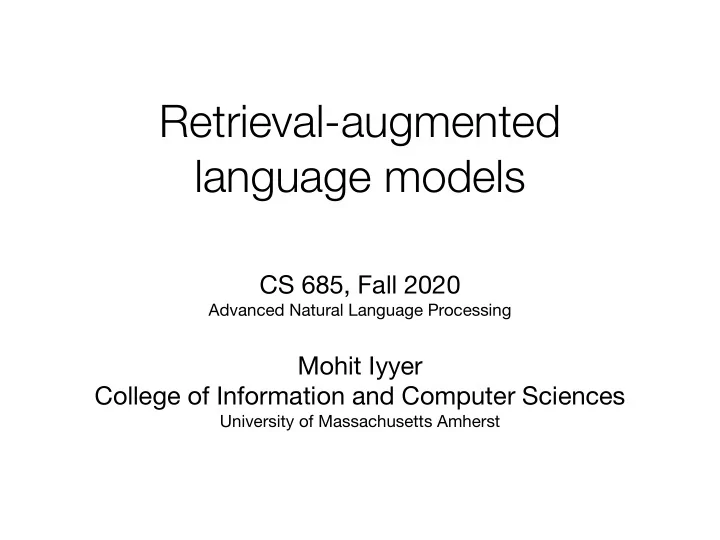

Retrieval-augmented language models CS 685, Fall 2020 Advanced Natural Language Processing Mohit Iyyer College of Information and Computer Sciences University of Massachusetts Amherst
barbershop: 54% BERT barber: 20% Bob went to the <MASK> ( teacher ): salon: 6% to get a buzz cut 24 layer stylist: 4% Transformer …
World knowledge is implicitly encoded in BERT’s parameters! (e.g., that barbershops are places to get buzz cuts) barbershop: 54% BERT barber: 20% Bob went to the <MASK> ( teacher ): salon: 6% to get a buzz cut 24 layer stylist: 4% Transformer …
Guu et al., 2020 (“REALM”)
One option: condition predictions on explicit knowledge graphs Wang et al., 2019
Pros / cons • Explicit graph structure makes KGs easy to navigate • Knowledge graphs are expensive to produce at scale • Automatic knowledge graph induction is an open research problem • Knowledge graphs struggle to encode complex relations between entities
Another source of knowledge: unstructured text! • Readily available at scale, requires no processing • We have powerful methods of encoding semantics (e.g., BERT) • However, these methods don’t really work with larger units of text (e.g., books) • Extracting relevant information from unstructured text is more difficult than it is with KGs
How can we train this retriever???
Knowledge- augmented encoder Neural knowledge retriever
Embed function is just BERT!
Isn’t training the retriever extremely expensive? Imagine if your knowledge corpus was every article in Wikipedia… this would be super expensive without the approximation
Maximum inner product search (MIPS) • Algorithms that approximately find the top- k documents • Scales sub-linearly with the number of documents (both time and storage) • Shrivastava and Li, 2014 (“Asymmetric LSH…”) • Requires precomputing the BERT embedding of every document in the knowledge corpus and then building an index over the embeddings
Need to refresh the index! • We are training the parameters of the retriever, i.e., the BERT architecture that produces Embed doc (z) • If we precompute all of the embeddings, the search index becomes stale when we update the parameters of the retriever • REALM solution: asynchronously refresh the index by re-embedding all docs after a few hundred training iterations
Other tricks in REALM • Salient span masking : mask out spans of text corresponding to named entities and dates • Null document : always include an empty document in the top- k retrieved docs, allowing the model to rely on its implicit knowledge as well
Evaluation on open-domain QA • Unlike SQuAD-style QA, in open-domain QA we are only given a question, not a supporting document that is guaranteed to contain the answer • Open-domain QA generally has a large retrieval component, since the answer to any given question could occur anywhere in a large collection of documents
Can retrieval-augmented LMs improve other tasks?
Nearest-neighbor machine translation Khandelwal et al., 2020
Nearest-neighbor machine translation Khandelwal et al., 2020
Nearest-neighbor machine translation Khandelwal et al., 2020
Nearest-neighbor machine translation Khandelwal et al., 2020
Nearest-neighbor machine translation Khandelwal et al., 2020
Nearest-neighbor machine translation Final kNN distribution Khandelwal et al., 2020
Interpolate between kNN prediction and decoder’s actual prediction Final kNN Decoder’s predicted distribution distribution Khandelwal et al., 2020
Unlike REALM, this approach doesn’t require any training! It retrieves the kNNs via L2 distance using a fast kNN library (FAISS)
This is quite expensive!
But also increases translation quality!
Can make it faster by using a smaller datastore
Recommend
More recommend